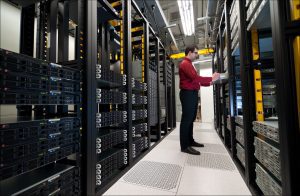I’m sharing the platform at DatacenterDynamics Stockholm today with Peter van Schaik, Director of ICT, Delft University of Technology. Like many establishments of stature, the University’s data centre is an important resource for its own operations including 7,000 researchers, teachers and support staff as well as its 17,000-plus student population. And like any organisation, TU Delft has an annual budget. So Peter needs to finely balance how much money is spent on data centre energy and how much he leaves on the table for education.
The data centre is an impressive and modern facility which includes 60 high density equipment cabinets, with 15kW rack/power density. These are arranged in hot aisle/ cold aisle configuration and the hot aisles have been enclosed. The data centre has been designed with both UPS power and cooling units installed in row with the IT equipment.
It’s the sort of forward thinking facility that any business would be proud of – providing the flexibility to scale up for increased demand, and modularity to right-size power and cooling capacity to closely match the IT load. Despite these advantages – the data centre was operating with a PUE of 1.53 – it was the realm of efficiency which Peter wanted to address.
Looking for ways to improve facility PUE and therefore lower the relative cost of production, Peter told me, “Although we set up our data centres with power efficiency in our mind, we were not sure if we have met our ‘green’ targets. Once we’d had our data centre in use for a couple of years, we made the decision to have a closer look at its efficiency. We decided to investigate if we could further optimize the PUE. So we started a project to gradually increase the internal temperature of the data centre. But as part of the project we also included a method to really measure the effectiveness and results of our actions.”
The means to measure the effectiveness of actions as Peter and his team raised the inlet temperatures to Delft’s IT servers is Schneider Electric’s StruxureWare Operations, DCIM software. His results are compelling as energy use and energy cost were tracked via the software tools during 2010 and 2011. Most notable on the graphs he’s presenting at DatacenterDynamics is the fact that during the warm summer months from June to September this year, there is a visible year-on-year drop in mechanical cooling and energy cost.
So there’s a lesson and a challenge here. There’s very little that any modern data centre designer could change or add to the Delft TU facility to make it more efficient. It is already run with a respectable PUE – better than average according to Uptime. The operations team have taken the important first steps to ensure its ongoing effectiveness; measuring, monitoring, evaluating, modelling change – you name it. But at the point when you’d think that team had done enough to satisfy the most exacting cost and environmental critics, Peter asked for just a bit more: Get that PUE down to an average 1.4.
“Just talking about “GREEN” IT is not enough, you really have to do something about it in all possible areas,“ says Peter van Schaik. The question for you is, when you’ve achieved a reasonable level of data center efficiency, do you stop there? Is enough really enough?

